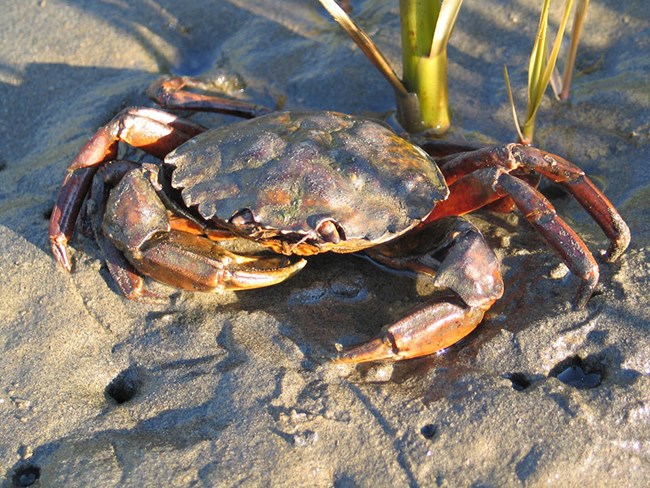Last updated: June 25, 2018
Article
Early Detection of European Green Crab in Washington’s Salish Sea

P. Sean McDonald
Crab Team is a project of Washington Sea Grant at the University of Washington that aims to learn about Washington’s inland shorelines and monitor them for invasion by the European green crab. We partner with volunteers, tribes, and agencies to survey habitats that could be affected by the globally-invasive crab, with the goal of detecting it at the earliest possible stage of establishment, increasing our chances of controlling populations and reducing impacts.
Introduction
Washington’s diverse and productive salt marshes and pocket estuaries, already threatened by shoreline development and pollution, now face a new invader. The European green crab (Carcinus maenas), considered one of the world’s worst invasive species, recently entered inland waters of Washington. If a population establishes, it could threaten native species in these habitats.
Green crab were first discovered on the US West Coast in San Francisco Bay in 1989, and spread to the outer coast of Washington, Oregon, and British Columbia on the El Niño currents of 1997/1998. However, it was not detected in the Salish Sea until 2012, when a population was found just west of Victoria in Sooke Inlet, raising concern that green crab could expand into Washington’s inland shorelines. The abundance of suitable habitat in this region, combined with conditions favorable for larval retention, increase the chance that green crab could reach substantial abundances here compared to coastal Washington.
In other parts of the world where green crab have invaded, they have been blamed for damaging shellfish harvests and eelgrass meadows. Research in California indicates they could outcompete young Dungeness crabs for food and shelter, and cause declines in populations of native shore crabs. Our best chance for mitigating potential impacts is to locate and remove populations before they become too abundant to control.
What Are We Doing?
Crab Team partners with volunteers, agencies and tribes to conduct monthly monitoring at 50 pocket estuary sites throughout Washington’s inland shorelines including at Third Lagoon, in San Juan Island National Historic Park.
Study Objectives
- Detect European green crab at the earliest possible stages of invasion, to increase potential to control and mitigate negative impacts on native species.
- Document impacts of European green crab on native species and habitats if they are successful at establishing a population.
- Build a long-term dataset on habitat features and community of mobile native crabs, fishes, and shrimps in Washington’s pocket estuaries, to provide a baseline and improve our understanding of these understudied habitats.
Study Methods
- Once per month, April through September, six baited traps of two types, each targeting different life stages of green crab, are set for an overnight high tide. All organisms in each trap are identified and counted. Sex and size are recorded for a subset of each crab species. All native organisms are released immediately, while green crabs, if captured, are removed.
- Monitors also conduct a systematic molt hunt, searching for 20 person-minutes for every crustacean shell that can be collected. All molts are counted by species to learn more about the crustacean community at the site.
- Habitat data, including wrack composition, vegetation and epifauna cover, and substratum category, are collected along a 50 meter shoreline transect.
What Do We Expect to Find?
We hope to characterize the phenology and community of crabs, shrimps, fishes, and mollusks living in Washington’s pocket estuaries. These often isolated habitats are important nurseries for juvenile salmon and Dungeness crabs, and provide foraging and breeding habitat for migratory and resident shorebirds, yet relatively little is known about how they differ over space and time, and the sum of their ecosystem services to the Salish Sea.
To date, European green crab have been found in only a few isolated locations, including Westcott Bay on San Juan Island, but we still hope never to find European green crab at this or our other sites.
Results to Date
Third Lagoon is a relatively high elevation shallow pocket estuary, meaning seawater only comes in on relatively high tides. This makes it more difficult for organisms to survive, as it can experience higher temperatures and lower oxygen conditions than sites with more water exchange. We believe this is why the trap catch at Third Lagoon was lower than the average of all other monitoring sites in 2016. This does not, however, mean that Third Lagoon is necessarily “unhealthy”, but help us learn about what conditions allow species to be more or less abundant.


Meet the Researchers

Emily Grason, Program Coordinator of WSG Crab Team, holds a Ph.D. in Biology from UW and studies the causes and effects of marine invasions.
Jeff Adams, Project Lead, is a Marine Ecologist at Washington Sea Grant. He has a M.S. from the School of Aquatic and Fisheries Science at UW.
Sean McDonald, Ph.D., is a regional expert on European green crab, having studied their West Coast range expansion and impacts for two decades. He is an instructor for the UW Program on the Environment Capstone Program and co-appointed at the UW School of Aquatic and Fisheries Science
Kate Litle, Assistant Director for Programs at Washington Sea Grant, advises Crab Team on Citizen Science. She has a Masters of Marine Affairs from the UW School of Marine and Environmental Affairs.
More Information
Web: wsg.washington.edu/crabteam
Email: crabteam@uw.edu
Twitter: @WAGreenCrab; Facebook: WSG Green Crab
Regina M. Rochefort, Ph.D.
North Cascades National Park Service Complex
Phone: 360-854-7202
